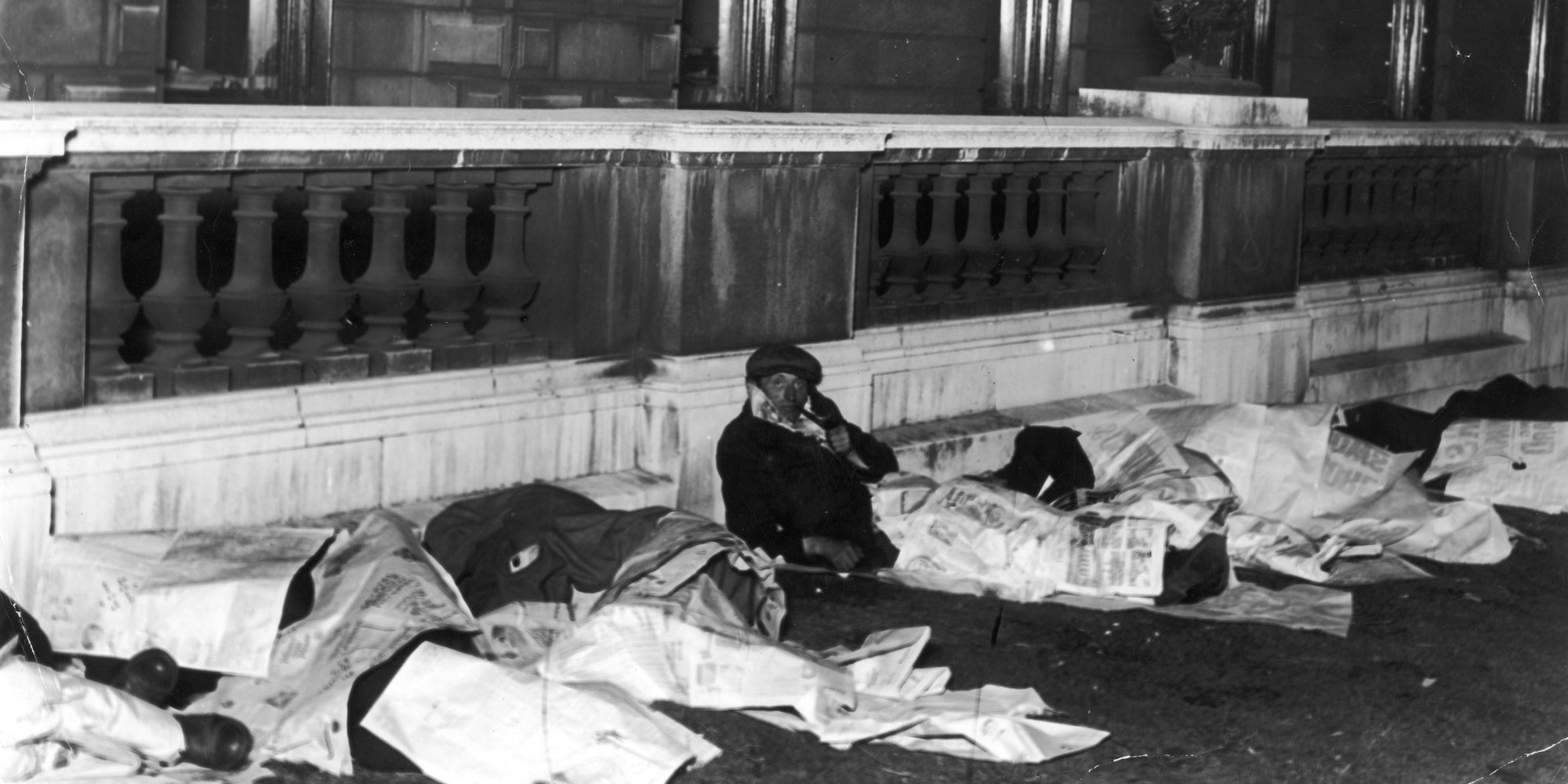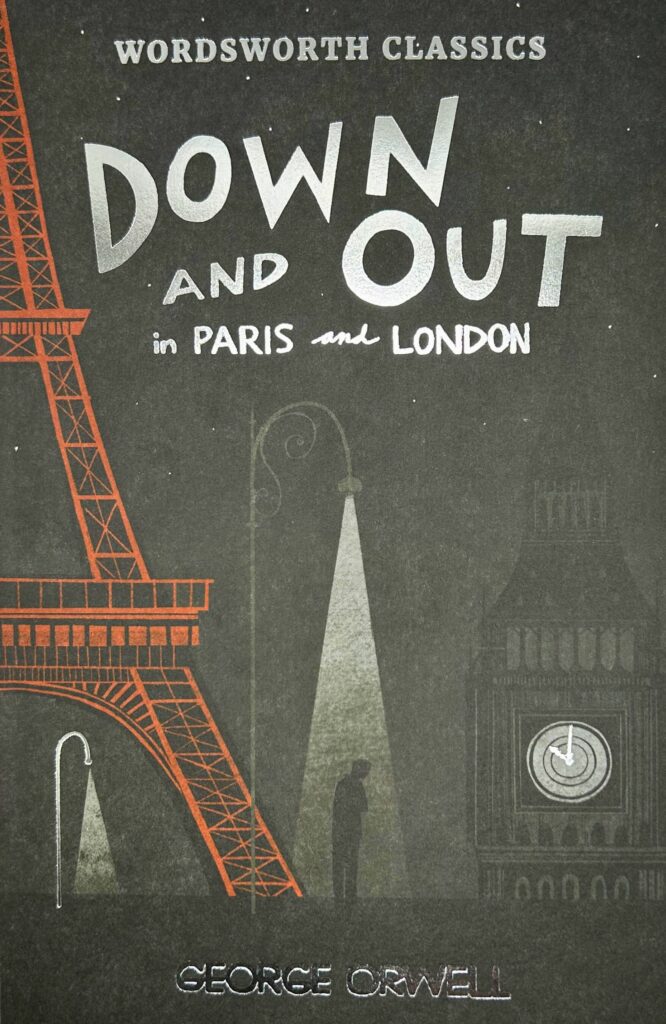
Sally Minogue looks at Down and Out in Paris and London & The Road to Wigan Pier
‘At least I could go amongst these people, see what their lives were like’: Sally Minogue looks at George Orwell’s Down and Out in Paris and London and The Road to Wigan Pier.
Look at any photograph of the poorest urban working-class people in Britain from the middle decades of the twentieth century, and you will see poverty ingrained in the image as surely as dirt is ingrained in their skin.[1] It is not unlike looking at those famous photographs of dustbowl America, of women whose faces have been pared down by malnutrition and desperation, whilst at the same time they try to feed a baby from an empty breast.[2] But those images are almost exoticised by the distance of America, another world, while the British photographs are of our culture, picturing recognisable towns and streets, part of our own lived history. Children are mucky, their clothes are mucky, and they play in mucky streets, dressed in ill-fitting hand-me-downs. At the same time, it is no surprise that much of life was lived on the street. The camera shows us domestic interiors that are terrifyingly close to the edge of what is humanly tolerable, walls streaming with damp and black with mould, one bed for several children, with inadequate covering. Somewhere outside desperate fathers are picking coal on spoil heaps, in the meanest of clothes, scarcely able to keep out what always looks like bitter cold.
George Orwell’s The Road to Wigan Pier (1937) is the written equivalent of those photographs; in it he tries to give a clear, honest and unflinching representation of working-class life lived at the very breadline, and sometimes below it:
As you walk through the industrial towns you lose yourself in labyrinths of little brick houses blackened by smoke, festering in planless chaos round miry alleys and little cindered yards where there are stinking dustbins and lines of grimy washing and half-ruinous wcs. (182)
In spite of the truism that a picture is worth a thousand words, writing, as we see here, can also do things that a photograph cannot. While we may be struck, even ‘pricked’, as Roland Barthes would say, by a photograph, with its immediacy and irresistibility (we can avoid it only by looking away), writing is inherently a more reflective medium.[3] The act of reading someone’s writing is linear, ratiocinative, and developmental, like the writing itself. It leaves more room for thought because it is an activity through time. Individual words can carry resonances and depths while the narrative mode adopted by the writer creates a relationship with the reader that can flex and change, even with each reader.[4] Here, Orwell seems almost to have us by the hand, wandering the streets beside him; we are included in that direct address but indeterminate second-person ‘you’ which is also a form of ‘I’. This assumed intimacy characterises his approach to the reader throughout the first half of Wigan Pier; from the opening paragraph, we are alongside him, hearing and seeing with him. He believes we will be interested in what he has to say. At times, indeed, he thinks we should be interested, and then his writing has a greater urgency and emotional weight. At other times, only the bare facts will suffice, because he feels it is somehow inauthentic to attempt to dress these up in any way: we must see them in all their bareness.
In Down and Out in Paris in London (the earlier text, 1933), he begins similarly in the midst of things, with his own personal impressions of a raucous Paris street. But his intent in this text is somewhat different. The ‘down and outs’ that he shows in two capital cities are at an even lower end of the scale than the families and miners he will live within Wigan. The characters here (which include Orwell himself, temporarily) are usually loners, their relationships with others transitory and uncommitted, their lives rootless, amoral, and hand-to-mouth. In Paris, these characters may have jobs, but even the jobs are part of a chaotic, contingent way of life in which uncertainty is the only certainty. In the second part of the work, set in London, Orwell focuses on the truly down and out: tramps, the homeless, those for whom the next day, the next night, is both unpredictable and horribly the same. He shows that there is a certain amount of choice in the way individuals have fallen into such lives; but once they are in those lives, the choice is taken away.
Orwell’s method in both of these seminal works is to live amongst those he wants to write about. He inhabits the life that they live; but at the same time, doing so is his own choice. His awareness of this advantage is written into both texts, but particularly so into The Road to Wigan Pier. There he explains himself:
At least I could go amongst these people, see what their lives were like and feel myself temporarily part of their world. Once I had been among them and accepted by them, I should have touched bottom, and – this is what I felt: I was aware even then that it was irrational – part of my guilt would drop from me. (250)
Ok, we might not have too much sympathy with an old Etonian’s heart searchings. But here for once is a member of a privileged class thinking hard about what it is like not to have that privilege – and then going out and trying to live without privilege himself. To my mind, this produces some of Orwell’s most powerful writing, the more so because he is always aware that he has a choice about the way he lives his life, whilst those he is writing about don’t.
This comes to the fore in a famous passage from Wigan Pier, where Orwell sees a young woman unblocking a drainpipe in the freezing cold. In the published text he turns this into a moment of psychological drama, as he glimpses the young woman from a train: he is leaving – she is stuck. In his Wigan diary entries, however, on which this passage is based, he is ‘passing up a horrible squalid side-alley’ when he ‘saw a woman, youngish but very pale and with the usual draggled exhausted look, kneeling by the gutter outside a house and poking a stick up a leaden waste-pipe, which was blocked … her expression was as desolate as I have ever seen.’ From this moment our writer makes a longer more reflective account for the published work. But central to both is the awareness on the part of both the writer and the woman of ‘how dreadful a destiny it was to be kneeling there in the bitter cold’. (159-160) He knows only too well that this is not his destiny.
Orwell may be a temporary participant in these lives, then, but he also shares them; yet at the same time he does not forget that his sharing is temporary and chosen. The same could be said for all those painters who have chosen to foreground the hardest of lives. I think of Van Gogh’s Peasant Woman, Kneeling, Seen From the Back, which catches all that back-breaking effort of fieldwork. We don’t even know what her task is, except that she is single in the field, on her knees, grubbing in soil. Then Gustave Caillebotte’s Floor Planers (Les raboteurs de parquet), Evelyn Dunbar’s Sprout Picking – all examples of back-breaking manual work. One of Orwell’s greatest achievements is to give a sense, through writing, of what it was like to be a miner in the 1930s. He self-deprecatingly records how physically hard it was for him to get through the mile or so of straitened corridor underground, bent double, just to reach the coal face where hours of grinding bodily work would then take place (165).
What Orwell reveals in Wigan Pier is a life of hardship that is thorough-going, at the domestic level as well as the working level. He gives us chapter and verse of the economics of being a miner (‘I have before me five pay-checks of a Yorkshire miner’, 175), including the regular ‘death stoppage’ – a sum charged to every miner to pay into compensation for anyone killed in a mining accident. Orwell emphasises that ‘death stoppage’ has its own rubber stamp, because it is so frequent. The more significant thing here to me is that the cost of compensation for these regular deaths accrued to other miners! These were regular stoppages, as were ‘hire of lamp’, ‘sharpening tools’, ‘infirmary’, ‘benevolent fund’, ‘insurance’ – costs that should have been borne by employers or state. Yet these are also lives lived in communities, families, they are social and sociable for all their difficulties. In one way that makes them better – there is after all human support, enjoyment and hope. In another way, though, as comparison with Down and Out shows, it means that the hardship of these lives is solidified and institutionalised by a system which endlessly maintains one class of people in a condition of hard manual labour, poverty and desperation. Curious comfort as it may seem, at least the characters in Down and Out are, finally, responsible to and for no-one but themselves, which may itself be a sort of choice.
These two works of Orwell’s are reflections on the contingent nature of freedom of choice. Who amongst us can say we have freely chosen our lives? But some are more fortunate than others in the conditions within which they can make those choices. Orwell speaks from a position of privilege, not only because of his class, but because he is a writer. In these texts, Down and Out in Paris and London and The Road to Wigan Pier, he wields his words to allow us as readers to inhabit the lives of others, and to reflect on our own.
Image: London Embankment homeless 1930 Credit: Chronicle / Alamy Stock Photo
[1] Bill Brandt’s photographs from the 1930s are good examples. Similar social conditions existed well into the 1960s and are recorded by, for example, Nick Hedges.
[2] I am thinking of the images of Dorothea Lange.
[3] Roland Barthes, Camera Lucida: Reflections on Photography (1980), trans. Richard Howard, London, Vintage, 2000, pp. 26-27.
[4] This is not to say that photographs cannot have these complexities – they can – but their impact is characteristically more immediate and inherently visual. The original first edition of The Road to Wigan Pier included photographs, which are hard-hitting images of social conditions, but they were not taken in the places Orwell wrote about, and he had no say in them. In that sense, they are distinct from the text, though they do indeed show the same harsh living conditions as he describes.
Books associated with this article
